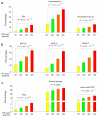Causal Associations Between Remnant Cholesterol Levels and Atherosclerosis-Related Cardiometabolic Risk Factors: A Bidirectional Mendelian Randomization Analysis
- PMID: 40004488
- PMCID: PMC11855473
- DOI: 10.3390/genes16020157
Causal Associations Between Remnant Cholesterol Levels and Atherosclerosis-Related Cardiometabolic Risk Factors: A Bidirectional Mendelian Randomization Analysis
Abstract
Background: Despite the widespread use of lipid-lowering agents, the risk of atherosclerotic cardiovascular disease (ASCVD) remains; this residual risk has been attributed to remnant cholesterol (RC) levels. However, the causal associations between RC levels and various atherosclerosis-related cardiometabolic and vascular risk factors for ASCVD remain unclear. Methods: Using genetic and biochemical data of 108,876 Taiwan Biobank study participants, follow-up data of 31,790 participants, and follow-up imaging data of 18,614 participants, we conducted a genome-wide association study, a Functional Mapping and Annotation analysis, and bidirectional Mendelian randomization analyses to identify the genetic determinants of RC levels and the causal associations between RC levels and various cardiometabolic and vascular risk factors. Results: We found that higher RC levels were associated with higher prevalence or incidence of the analyzed risk factors. The genome-wide association study unveiled 61 lead genetic variants determining RC levels. The Functional Mapping and Annotation analysis revealed 21 gene sets exhibiting strong enrichment signals associated with lipid metabolism. Standard Mendelian randomization models adjusted for nonlipid variables and low-density lipoprotein cholesterol levels unraveled forward causal associations of RC levels with the prevalence of diabetes mellitus, hypertension, microalbuminuria, and metabolic liver disease. Reverse Mendelian randomization analysis revealed the causal association of diabetes mellitus with RC levels. Conclusions: RC levels, mainly influenced by genes associated with lipid metabolism, exhibit causal associations with various cardiometabolic risk factors, including diabetes mellitus, hypertension, microalbuminuria, and metabolic liver disease. This study provides further insights into the role of RC levels in predicting the residual risk of ASCVD.
Keywords: Mendelian randomization; cardiometabolic risk factor; diabetes mellitus; genome-wide association study; metabolic liver disease; remnant cholesterol.
Conflict of interest statement
The authors declare that they have no known competing financial interests or personal relationships that could have appeared to influence the work reported in this paper.
Figures





References
-
- Ting H.J., Stice J.P., Schaff U.Y., Hui D.Y., Rutledge J.C., Knowlton A.A., Passerini A.G., Simon S.I. Triglyceride-rich lipoproteins prime aortic endothelium for an enhanced inflammatory response to tumor necrosis factor-α. Circ. Res. 2007;100:381–390. doi: 10.1161/01.RES.0000258023.76515.a3. - DOI - PubMed
MeSH terms
Substances
Grants and funding
LinkOut - more resources
Full Text Sources
Medical

